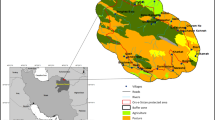Abstract
This study attempted to discern the main likely wolf-human conflict contributing variables in households of Shabestar county’s villages. Data were collected through questions in 53 semi-structured interviews in 36 villages across Shabestar in summer 2014. The results suggested that people who have reportedly suffered livestock depredation and who have alternative income sources to livestock are likely to be particularly hostile toward wildlife. With rapid assessment of households using these few key variables, we are able to identify likely conflict hotspots and target conflict resolution efforts in those villages. Based on these results, the most important initial strategies for reducing conflict would be reducing the number of livestock killed by wolf, increasing opportunities to generate income only from livestock holdings rather than alternative income sources.


Similar content being viewed by others
References
Dickman AJ (2008) Key determinants of conflict between people and wildlife, particularly large carnivores, around Ruaha National Park, Tanzania. University College London, London
Islamic Republic News Agency (IRNA) (2015) Http://www.irna.ir/fa/News [accessed 20 June 2015] (In Persian)
Lamprey RH, Reid RS (2004) Expansion of human settlement in Kenya’s Maasai Mara: what future for pastoralism and wildlife? J Biogeogr 31:997–1032
Mishra C (1997) Livestock depredation by large carnivores in the Indian Trans-Himalaya: conflict perception and conservation prospects. Environ Conserv 24:338–343
Naughton-Treves L, Treves A (2005) Socio-ecological factors shaping local support for wildlife: crop-raiding by elephants and other wildlife in Africa. In: Woodroffe R, Thirgood S, Rabinowitz A (eds) People and wildlife: conflict or coexistence? Cambridge University Press, Cambridge, pp 252–277
Naughton-Treves L, Grossberg R, Treves A (2003) Rural citizens’ attitudes toward wolf depredation and compensation. Conserv Biol 17(6):1500–1511
Suryawanshi KR, Bhatnagar YV, Redpath S, Mishra C (2013) People, predators and perceptions: patterns of livestock depredation by snow leopards and wolves. J Appl Ecol 50:550–560
Ziaie H (2011) A field guide to the mammals of Iran, 4th edn. Iranian Wildlife Center, Tehran, In Persian
Author information
Authors and Affiliations
Corresponding author
Rights and permissions
About this article
Cite this article
Habibzadeh, N. Key determinants of human-wolf conflict in Shabestar county’s villages of East Azerbaijan province, Iran. Eur J Wildl Res 62, 199–202 (2016). https://doi.org/10.1007/s10344-016-0993-1
Received:
Revised:
Accepted:
Published:
Issue Date:
DOI: https://doi.org/10.1007/s10344-016-0993-1




